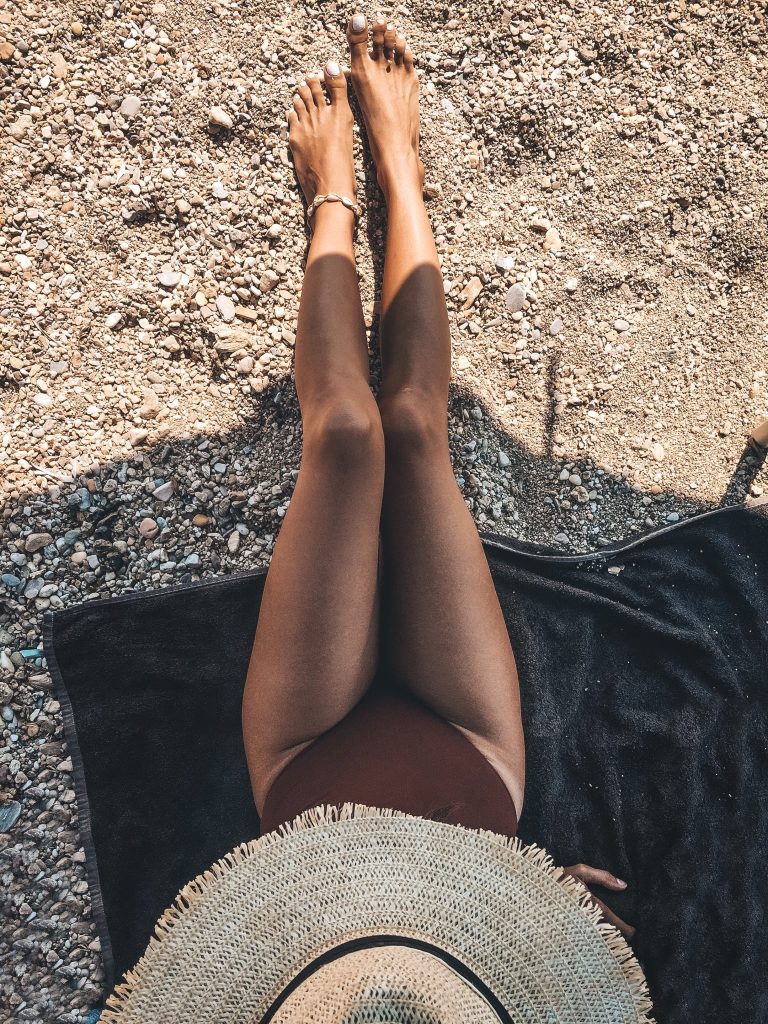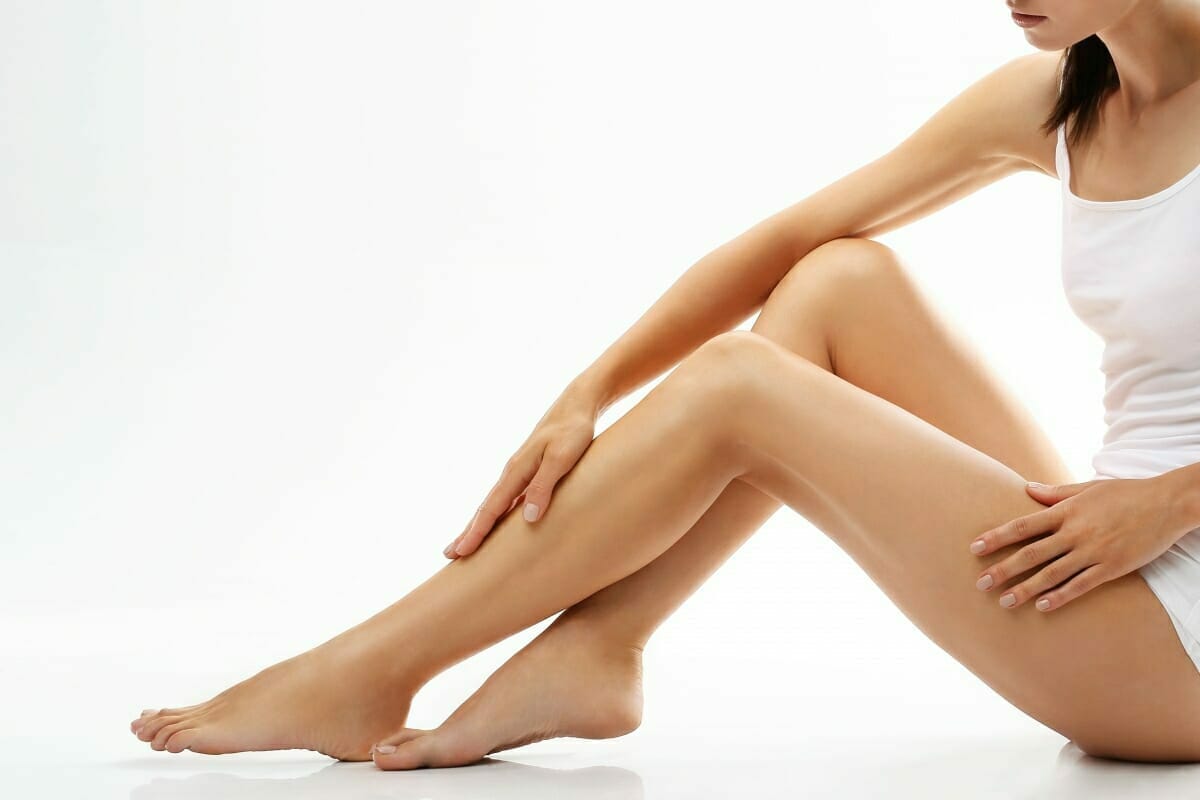Beautiful legs without disturbing spider veins through so-called sclerotherapy or foam sclerosis. With tiny injections, the bluish veins that shimmer through the skin are permanently eliminated. It’s best to carry out the treatment during the cold season.
Important Facts
- Treatment duration: 15-30 minutes
- Anesthesia: none
- Aftercare: Compression stockings for 4-5 days, no sun exposure, no solarium, no hot baths or sauna visits for 4-6 weeks
- Result: After about 4-6 weeks. Several sessions may be necessary.
- Pain level: Low, only tiny punctures with very fine cannulas
- Social readiness: Immediate
- Price: from 180€
What are Spider Veins
Small, bluish dilated veins lying directly beneath the skin surface, predominantly on the legs, are called spider veins. These harmless vascular changes, which affect women more often than men, are often perceived as disturbing because they are visible through the skin.
Are Spider Veins Dangerous?
The most important thing first: Spider veins are not dangerous and, if at all, merely an aesthetic problem.
Only when the causes lie in venous insufficiency, where the vein valves no longer close completely and the blood repeatedly sinks back, leading to the formation of varicose veins, is there a real health problem. In such a case, a vein specialist is the right contact person who can treat varicose veins with various methods before serious long-term damage to the skin occurs.
How Can I Prevent the Formation of Spider Veins?
Prevention is limited because the cause is usually a weakness of the connective tissue, which causes an expansion of the vein walls. Long periods of standing or sitting, pregnancies or taking birth control pills, as well as being overweight can also promote their development.
What Can Be Done About Spider Veins?
If left untreated, spider veins do not recede on their own and can increase over time.
Estrogens promote their formation, which is why women are more often affected than men. Estrogen-containing medications such as birth control pills can promote the increase of spider veins in those with a predisposition.
With exercise and weight control, one can counteract the formation. However, existing spider veins will not recede with these measures.
All sports that strengthen the leg muscles and reduce weight have a positive effect. During long periods of sitting (during work or on long trips), you should also do some leg exercises regularly to prevent blood from pooling in the legs: sit upright, place your feet flat and alternately rock on your heels and toes.
Existing spider veins can be eliminated with sclerotherapy or also known as vein obliteration.

How Does Spider Vein Treatment Work
With the help of sclerotherapy (spider vein removal, obliteration, foam sclerosis), the spider veins can be closed from the inside using fine cannulas. A substance called Aethoxysklerol is applied in tiny amounts to the inside of the dilated vein, causing a local irritation of the vein wall that ensures the vessel walls stick together. The sclerosed vessel is then broken down by the body’s own defense system over the next days and weeks.
After the spider vein treatment, compression stockings must be worn for 4 to 5 days to achieve optimal results.
Sauna visits, hot baths, or local heat applications should be avoided for a period of four weeks. Sun exposure or solarium should also be avoided for about six weeks, as this can lead to dark discoloration of the skin. For this reason, it is recommended to have the spider vein treatment done during the colder season.
To achieve the desired result, several treatments may be necessary. The therapy is performed on an outpatient basis and is generally not very painful. Only small puncture sites with fine cannulas can be felt. Small bruises in the injection area disappear without problems after a few days. The patient can leave the practice immediately after the procedure.

Frequently Asked Questions (FAQ) About Foam Sclerosis of Spider Veins
Do I Need to Undergo Special Examinations Before the Foam Sclerosis of Spider Veins?
Sometimes, spider veins can also be caused by an underlying venous condition. Especially if you frequently suffer from heavy and swollen legs, an ultrasound examination of the leg veins is recommended to rule out an underlying venous disease. If venous insufficiency with incompletely closing vein valves or varicose veins are present simultaneously, these should be treated first, as otherwise, the spider veins may recur. In this case, a vein specialist is the right person to consult.
What is the difference between spider veins and varicose veins?
Spider veins are small, bluish, dilated vessels shimmering under the skin. Varicose veins are thick, string-of-pearls-like dilated superficial veins. Unlike spider veins, varicose veins are not just an aesthetic problem but are also detrimental to the entire venous system.
Does foam sclerotherapy for spider veins hurt?
You will feel small pricks and a burning sensation, but overall, foam sclerotherapy for spider veins is not very painful.
Do spider veins disappear immediately after foam sclerotherapy?
No. While the spider veins disappear immediately when the solution is injected, they then reappear and initially look even darker than before the sclerotherapy. This is a sign of the inflammation occurring inside the vessels. This leads to the adhesion of the vessel walls. After blood no longer flows through the dilated vessel, the now closed spider vein is broken down by the body’s own defense system within a few weeks.
Is it necessary to remove spider veins?
If the spider veins are not caused by an underlying venous condition, they are solely a cosmetic issue. This means they do not harm your health. The only reason to remove them is if you find them aesthetically disturbing. It is not true that a small spider vein can later turn into a varicose vein if left untreated.
However, you should check whether the spider veins are not a symptom of a serious additional venous disease, especially if you suffer from heavy legs, swelling of the legs, or skin changes around the ankles.
What is the best season for removing spider veins?
After foam sclerotherapy of spider veins, the treated body areas should not be exposed to the sun under any circumstances, as this can lead to the formation of dark spots. For this reason, the treatment should be carried out during the cold season.
Additionally, you need to wear compression stockings for two weeks after the spider vein treatment, which is very uncomfortable in summer.
(A small tip for compression stockings: I recommend my patients to buy compression stockings in black or dark gray, instead of beige or white, as these are less noticeable and more suitable for everyday wear.)
What should I consider after the removal of spider veins?
After spider vein treatment, you should absolutely avoid sun exposure to prevent pigmentation disorders. Heat applications such as saunas or steam baths should also be avoided for several weeks.
How long does it take for spider veins to disappear after treatment?
After the removal of spider veins, you need to be patient for about 6 weeks until you see the final result.
Is the treatment of spider veins covered by health insurance?
Since foam sclerotherapy of spider veins is purely an aesthetic treatment, the costs are not covered by health insurance.
How many treatments are necessary for the removal of spider veins?
Sometimes not all spider veins disappear after just one treatment, so a second session may be necessary. You should also keep in mind that if you have a predisposition, spider veins can unfortunately always come back, even if they have been sclerosed before.
Can I exercise after foam sclerotherapy?
Light sports activities such as running, cycling, walking, or swimming are allowed about two to three days after spider vein removal.
How long do I have to wear compression stockings after sclerotherapy?
To achieve optimal results, you should wear the compression stockings all the time for 4 days and then during the day for 2 weeks when standing or sitting for extended periods.
Do spider veins come back after sclerotherapy?
Unfortunately, spider veins can come back after sclerotherapy if you have a predisposition for them. In such a case, the treatment can be repeated without any problems.
Does the treatment of spider veins have side effects?
In rare cases, small bruises may occur, which will soon disappear. In the days following the treatment, the freshly sclerosed spider veins can be seen as dark purple-bluish lines under the skin. Some patients may feel a slight tingling sensation in the first few days after treatment, which soon subsides.
Why did my spider veins increase during pregnancy?
The reason for this is, on the one hand, that during pregnancy, the increased estrogen causes the connective tissue to loosen, making room for the baby and preparing the body for birth.
Doesn't my body need the spider veins?
No, spider veins do not serve any important function for blood transport, so it is not a problem for the body if they are closed using foam sclerotherapy.
What makes spider veins worse?
Particularly bad is standing or sitting for long periods with crossed legs. This prevents blood circulation and causes blood to accumulate in the veins.
Which sport helps against spider veins?
There is no sport that will make spider veins disappear. However, exercise can often prevent or at least slow down the appearance of new spider veins. Water sports are particularly suitable. Here, not only are the muscles exercised, but the venous and lymphatic systems of the legs are also optimally supported by the surrounding water pressure.
Which cream makes spider veins disappear?
Unfortunately, the miracle cures against spider veins often advertised on the internet with many promises are not effective and only cost a lot of money. If you really want to remove your spider veins, only foam sclerotherapy or laser treatment are real therapeutic methods.
Am I socially presentable after spider vein treatment?
You can leave the practice immediately after the foam sclerotherapy. Right after the treatment, you put on the compression stockings. After that, you can return to your usual daily activities.
